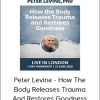Peter Levine – How The Body Releases Trauma And Restores Goodness
$80.00$199.99 (-60%)
Summarize the process of how overwhelming stress leads to somatic and emotional syndromes in clients.
Peter Levine – How The Body Releases Trauma And Restores Goodness
Check it out: Peter Levine – How The Body Releases Trauma And Restores Goodness
International trauma expert and author, Peter A. Levine, Ph.D. will teach you how sensation-based treatment (as opposed to emotional or rational-based treatment) can be effective for trauma treatment. He discusses the important principles in successful trauma treatment, and uses his own successful renegotiation of a personal traumatic event as an example.
Representing the full scope of his life’s work, Dr. Levine discusses the evolutionary underpinnings of trauma. This recording includes an in-depth review of how trauma is related to the ethnological concept of tonic immobility, as well as the roadmap of the Polyvagal system – a fascinating neurophysiological model for understanding how we shift between the states of fight-or-flight, shutdown, and social engagement. Dr. Levine provides simple containment tools to help you develop your awareness of these state changes in order to more effectively engage your client in trauma therapy.
- Articulate the four major developmental stages that increase vulnerability to trauma and how to recognize them in your clients.
- Determine the naturalistic mechanics of trauma and survival responses of flight, fight, freeze and collapse as it relates to clinical treatment.
- Discover the evolutionary underpinnings of trauma and the Polyvagal theory and their clinical implications.
- Demonstrate the importance of “Bottom-up” processing versus “Top Down” processing to improve treatment outcomes.
- Summarize the process of how overwhelming stress leads to somatic and emotional syndromes in clients.
- Incorporate Dr. Levine’s simple containment tools in order to more effectively engage your client in trauma therapy.
Would you like to receive Peter Levine – Peter Levine PhD on Trauma, How the Body Releases Trauma and Restores Goodness ?
Child Development: The Signs of Trauma in Each Developmental Period:
- Pre-Natal
- Hormonal interactions between mother and child
- Birth Stress
- Year One
- Safety, affection and containment
- Proprioceptive development
- The Dopamine System
- The space to explore one’s effect on the world
- The formation of a self that is different from Mom and Dad
- Testing boundaries
- Age 3-5
- The Biology and balance of shame
- The importance of shame in society
- The signs of overshaming
- The signs of undershaming
- The initial forays into sexuality
- The importance of flirting
- How these sames stages replay themselves out in later life
- The initial forays into sexuality
The Naturalistic Mechanisms of Trauma
- Understanding our primary survival tactics and how they play out in the body: Flight, fight, freeze and collapse
- 500 million years of evolution: Our Polyvagal underpinnings
- How the Dorsal Vagal System is related to shutdown and collapse
- Fight or flight: Sympathetic/adrenal System mobilization, Returning to our Mammalian birthright: The Ventral vagal system and social engagement
- How we get “stuck”
- Tonic immobility – The fallback to freeze
- Freeze couples with Fear
- Dissociation
- Bracing and terror
- Euphoric dissociation
- Collapse
- Somatic and emotional – syndromes and complexes
- Emotional – anxiety, depression
- Somatic – chronic pain, fibromyalgia
- Autonomic – migraines, irritable bowel
Resolving Traumatic Reactions
- The importance of “Bottom-Up” processing
- The Paul MacLean’s Triune Brain
- In an Unspoken Voice
- Somatic Experiencing©
- Renegotiation vs. Reliving
- Restoration of self-regulation
- Trauma isn’t about the event, but the body’s inability to process and integrate the nervous system charge
- The importance of developing a felt sense
- The nine basic stages of trauma treatment
- Containment of strong sensation and emotion
- Pendulation – The dual opposites of sensation
- Titration – going gradually
- Completion
- Renegotiation of active for passive responses
- Simple exercises that you can use in your practice
Spirituality and Trauma
- Trauma as one of the 4 avenues to enlightment
- Lessons from the Kundalini
- A feeling of “okayness”, wholeness and trust in the world
- And other side effects of effective trauma treatment
- The importance of maintaining balance in one’s life









































